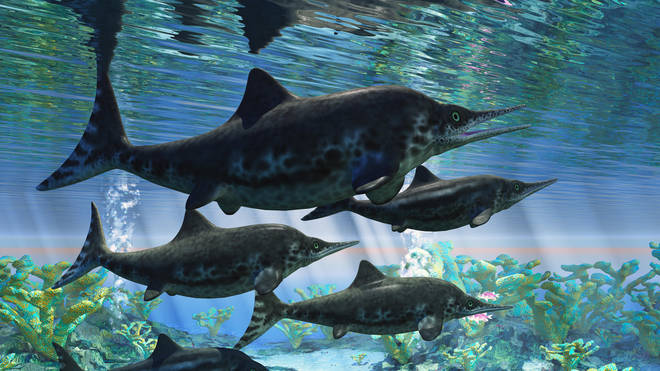December 20, 2022

Ex-US President Donald Trump embraces Arizona Republican gubernatorial nominee Kari Lake at a campaign rally at Legacy Sports USA on October 9, 2022 in Mesa, Arizona, US.
Arizona is ground zero for the wackiest theories and craziest political candidates.
Exhibit A: Kari Lake, the Republican who ran for governor in the recent midterm elections. Though she lost in November, she's still campaigning — on social media, in the courts, and in her own beclouded imagination. She refuses to accept that Katie Hobbs, her Democratic opponent, won by 0.6% of the vote. It's a delusion she shares with Donald Trump who tweeted that Lake should be "installed" in the position anyway, like a triumphant coup leader. Lake, Trump, and all-too-many Americans now believe that any election in which a MAGA extremist doesn't achieve a pre-ordained victory is, by definition, "stolen."
Then there's Blake Masters, the losing Arizona Republican Senate candidate, who accused the Biden administration of encouraging millions of immigrants to enter the United States "to change the demographics of our country." That's a clear reference to the "great replacement" theory according to which outsiders (foreigners, non-Whites, Muslims), abetted by liberals and globalists, are using immigration and higher birthrates to replace "indigenous" White majorities. It has become ever more popular among White nationalists, alt-right activists, and mass murderers from El Paso to New Zealand who cite it in their manifestos.
Perhaps the craziest of that crew is Ron Watkins, the leading proponent of the QAnon cult of misinformation, who moved to Arizona to run for Congress. According to QAnon, an international cabal of Satanic pedophiles extract and consume a mysterious substance found in the bodies of trafficked children. Oh, and these well-connected devil-worshippers also control the United Nations, the global economy, and even the Oscars.
Watkins never made it out of the primaries, but Lake and Masters ran very close races, while other conspiracy theorists did win seats in the Arizona state senate, including election-denier Wendy Rogers, January 6th insurrection attendee Anthony Kern, and QAnon supporter David Farnsworth. Don't be fooled by their campaign literature. Those Arizona Republicans and others like them across the country are not conservatives. Rather than preserve the status quo, they want to overturn democratic institutions, as well as elections.
Their success should come as no surprise. A large number of Arizonans believe that the government lies about everything from the Covid pandemic to the availability of water, and paramilitary groups like the Patriot movement have made inroads into that state's politics. The three most widespread and demonstrably false far-right narratives — globalist-Satanists control the economy, elections are being "stolen," and foreigners are out to "replace" Whites — flourish in a state that, long, long ago, gave the world Barry Goldwater, the original radical right-wing politician.
But it's a mistake to attribute the strong showing of those far-right candidates solely to such crazy talk. Exit poll data from the last election suggests that Arizona Republican voters prioritized very real bread-and-butter issues like inflation, which was causing them significant hardship. No matter what you think of rising prices, they're real, unlike the macabre fictions of QAnon. And it wasn't only White nationalists who supported such candidates. Kari Lake, for instance, picked up 47% of the Latino vote.
Sure, the far right attracts plenty of "deplorables" from outright racists and homophobes to QAnon crackpots. But far more of those who support candidates like Kari Lake and her global counterparts — Giorgia Meloni in Italy, Jair Bolsonaro in Brazil, and Narendra Modi in India, among others — are actually "persuadables," voting in their perceived self-interest based on perfectly real economic and political needs. By courting such voters, the far right has managed to pivot from the fringe to the mainstream.
And those same persuadables may now hold the key to the future of democracy.
What motivates far-right voters
Not so long ago, Sweden would have been considered the un-Arizona. In the post-World War II era, that Scandinavian state became the symbol of democratic socialism. Yet even there, the far right has gained ground, precisely by reaching those persuadables.
For one thing, though Sweden is still far more equitable than the United States, it's no longer quite so socially democratic. In the 1980s and 1990s, a series of center-left governments cut back on barriers to the free flow of capital and trade, helping to globalize that country's economy, and paving the way, in 2006, for a center-right government that implemented neoliberal tax cuts and rolled back welfare programs.
The result: a marked increase in economic inequality. From 1980 to 2019, the transfer of wealth to the richest one percent of Swedes was on a par with Thatcherite England and so, by 2017, that country had a greater per-capita concentration of billionaires than any other in Europe, except Switzerland. In 2019, The Economist reported approvingly on the sheer number of Swedish super-rich and also their apparent popularity.
But not with all Swedes, it turns out. The neoliberal globalization of that economy also produced lots of "losers," who now support the Swedish Democrats. Founded in 1988 and led by neo-Nazis, that party held early meetings that, according to Le Monde, featured "brown shirts and party members performing the Nazi salute, and their security was provided by skinheads." After new leaders jettisoned the Nazi trappings and focused instead on the immigrant "threat," the party began to climb in the polls, coming in second in last September's elections with 20.5% of the vote and so helping a new right-wing government take over.
To break into the mainstream, that previously marginal party increasingly relied on its populist economic platform, offering to increase government handouts and cut some taxes to appeal to working-class voters and the unemployed. Racism and Islamophobia have certainly played a role in boosting support for it, but the party has benefited most from a surge of anger at the economic austerity policies that have made Sweden one of the least equal countries in Europe.
Across that continent, the far-right has relied on anti-globalization messages, effectively raising a middle finger to both the European Union and world financial institutions. In the east, such parties have won power in both Poland and Hungary, while, in the west, they have siphoned off votes from Communist parties in France, Italy, and elsewhere.
If opposition to austerity politics has been the meat and potatoes of such far-right parties, the special sauce has been social messaging, especially about immigration. When it comes to ginning up fear and resentment, border-crossers are the perfect scapegoats. The Sweden Democrats, for instance, have promised to deport immigrants who have committed crimes or are simply "asocial" and they don't want to accept more migrants unless they come from neighboring (in other words, White) countries.
The far right is obsessed with those who cross not just territorial borders, but also the more conceptual borders of gender, sex, and race. In Hungary, Prime Minister Viktor Orbán changed the constitution to define marriage as solely between a man and a woman, while effectively banning adoption by same-sex couples. Italian Prime Minister Giorgia Meloni declared that her party says "yes to natural families, no to the LGBT lobby, yes to sexual identity, no to gender ideology." Jair Bolsonaro spent his term as Brazilian president denying the existence of racism in his country while undermining the rights of indigenous communities.
At the heart of such far-right social policies is an effort to assuage the anxieties of dominant groups — Whites, men, heterosexuals, Christians — over the erosion of their economic status and reassure them that they won't suffer a decline in social position as well. In the process, left and liberal parties, which might once have appealed to voters left behind by globalization and neoliberalism, have lost out on what should have been "their" issues.
Crafted to appeal to voter interests, the far-right agenda can often seem far indeed from the universe of conspiracy theories in which Jews control the world through financier George Soros or leaders of the Democratic Party run a child trafficking ring out of the basement of a pizza restaurant in Washington, D.C. Still, a major reason for the far right's success has been its ability to toggle between pragmatic policies and extremist messaging.
Two Sides of the Same Coin
A month before the Italian elections, Giorgia Meloni released a curious six-minute video in which she managed to effortlessly switch from English to French to Spanish. In the process, she denounced Nazism and anti-Semitism, while pledging her support for NATO and Ukraine.
In those six minutes, Meloni introduced herself to the rest of Europe as a multilingual cosmopolitan who rejects the fascist roots of her own party. Inside Italy, the video appealed to those appalled by the far right's flirtation with Vladimir Putin and concerned that its rise to power might jeopardize the European Union's financial support. Precisely because Meloni didn't deliver those remarks in Italian, the speech was less likely to alienate her core nationalist supporters.
The Meloni video is a perfect case of code-switching: speaking in different ways to different audiences. Far-right politicians around the world are often remarkably adept at switching the crazy on and off, depending on their audience. Viktor Orbán has typically been careful to keep his anti-immigration views couched in race-neutral terms. Only when talking to ethnic Hungarians in Romania did he frankly admit that Hungarians don't want to become a "mixed race." Pauline Hansen, leader of a far-right Australian party, thought she was addressing a gun lobbyist when she floated the outlandish notion that the country's worst mass shooting in 1996 was a false-flag operation to boost gun control. Running for the Senate in Ohio, J.D. Vance typically voiced many conspiracy-laden views — the 2020 election was stolen, discredited radio host Alex Jones was "a far more reputable source of information than Rachel Maddow" — that he would never have defended before more liberal audiences.
"Dog-whistling" is just another version of this phenomenon, where politicians embed coded language in their speeches to address different audiences simultaneously. References to "law and order," "family values," or "globalists" can mean different things to different people. Only the in-crowd will understand the Pepe the Frog image in a right-wing politician's tweet. Attendees at a Trump rally might hear a catchy tune without realizing that it sounds a lot like the QAnon anthem.
What makes this code-switching and dog-whistling so dangerous is the proximity of the crazy and sane parts of the far right's discourse. In fact, the three most prominent false narratives just happen to map neatly onto the far right's three most prominent mainstream appeals.
So, for instance, the economic policies of globalization and neoliberalism have indeed created hardships for certain communities like blue-collar workers, rural residents, and older voters. And while such policies are pushed by powerful institutions like transnational corporations and banks, they are not the result of a Jewish conspiracy, a cabal of Satanists, or a group of globalists with a shadowy "great reset" plan to use Covid to destroy the sovereignty of nations.
Mainstream parties the world over are indeed full of corrupt politicians who often do their damnedest to game the system. Still, the notion that liberals and leftists have "stolen" elections in the United States or Brazil by hacking electronic voting systems or fabricating thousands of ballots has been debunked over and over again.
War, civil unrest, and climate change have indeed created one of the largest waves of refugees and immigrants since World War II. Those poor souls are desperate to find shelter and safety in other countries. But they have no plan to "replace" the majority White populations of Europe, the United States, or Australia. In truth, many would return home if only it were possible.
By their very proximity, the illegitimate arguments borrow a veneer of credibility from the legitimate ones, while the latter derive some raw power from the former. It's just one short step, for instance, from acknowledging the corruption of political parties to believing they've stolen elections. Ironically enough, if anyone's trying to rig elections, it's far-right parties — Republicans using voter suppression tactics or Hungary's Fidesz party controlling the media landscape to reduce the public voice of the opposition. The far-right frequently projects onto its adversaries the very sins it routinely commits behind the scenes.
Worst case, best case
In his September 30th speech announcing the annexation of four provinces of Ukraine, Russian President Vladimir Putin engaged in his now-familiar uber-nationalism to justify the abrogation of international law. But he also took several bizarre detours. Western countries, he argued, were advancing toward "outright Satanism." Moreover, the West "is ready to step over everything in order to preserve the neo-colonial system that allows it to parasitize, in fact, to plunder the world." Finally, he decried all those who tell children "that there are various supposed genders besides women and men" and offer them "a sex-change operation."
These were odd assertions in what should have been a speech focused on geopolitics, but Putin was dog-whistling like crazy. He was sending a message to his far-right supporters at home and abroad that he, too, believed Satanic liberals controlled the world and were indeed "grooming" children to change their sexuality and gender.
Unlike Giorgia Meloni, Putin doesn't need to move to the center to reassure European allies or win over independent voters. The invasion of Ukraine severed his ties to Europe — even to the European far right — and he's rigged elections in his own favor for years. His unfettered use of false narratives offers a nightmarish look at what would likely happen if far-right politicians around the world were to win ever more elections, rewire democracies to ensure their future dominance, and begin to take over international institutions like the European Union or even the World Bank. Untethered from the compromises of electoral politics, the far right will forget about those persuadables and, like Putin, let its freak flag fly.
It's still possible to head off the next set of Putins, Melonis, and Trumps at the pass. But that means avoiding the false temptation to promote comparably crazy stuff or appealing to true deplorables. Instead, a coalition of the sane must try to understand the real political and economic reasons why those persuadables vote for Kari Lake and her brethren — and then craft arguments and policies to win them over.
It can be done. Even as Italy turned to the far right, just enough voters rejected Kari Lake and Jair Bolsonaro at the polls. Despite Trump-driven Republican politics and an Elon Musk-driven Twitter, the crazy can be constrained and the radical right rolled back. But that means engaging citizens where it matters most: their heads, their hearts, and above all their pocketbooks.




